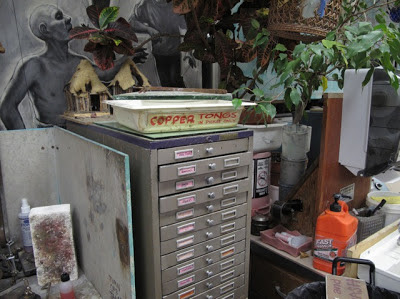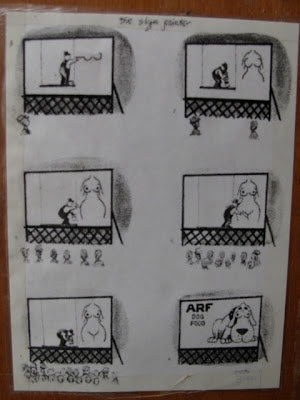I had a lot of fun snooping around a friend's high school art classroom.
Unfortunately many teachers who work in our public school systems are finding that the arts are no longer a top priority.
Faced with dilemmas like how to raise test scores and how to stretch budgets as far as they can go ~ policy makers are increasingly looking to cut arts education in the schools.
Trouble is, many hold the misconception that art is a superfluous, isolated subject when, in fact, nothing could be further from the truth.
My friend Deb is a High School Art Teacher and she says that teaching her students about art is an essential element in a well rounded education.
I thought you might enjoy a stroll through her (very interesting) classroom via photographs.
It's been proven that early exposure to visual art, music, or drama promotes activity in the brain. Art helps children understand other subjects much more clearly - from math and science, to language arts and geography.
Art nurtures inventiveness as it engages children in a process that aids in the development of self-esteem, self-discipline, cooperation, and self-motivation.
Participating in art activities helps children gain the tools necessary for understanding human experience, adapting to and respecting others' ways of working and thinking, developing creative problem-solving skills, and communicating thoughts and ideas in a variety of different and unique ways.
Teaching children about art is not just about showing them how to recognize a Rembrandt or a Picasso.
Drawing can provide the basis for other creative activities - like painting, sculpture and printmaking - but it also provides a direct link with reading, writing and especially mathematics.
Art stimulates both sides of the brain.
Nearly one third of all children are visual learners.
There are studies that show that children who make art, read better and get better grades in science and mathematics.
Children learn by using their senses and art is ideal in this process
Children need a safe place to express themselves at school.
The creation of art promotes self esteem.
Art encourages children to be aware of - and give more attention to - the physical space that surrounds them.
Art develops hand and eye coordination.
Art stimulates perception.
Art teaches a child to think openly. It represents a culture of questioners - more than a culture of responders.
Art teaches that there is more than one solution to a problem.
Art teaches children to think creatively to solve problems.
Children can share and reflect on their particular work of art and learn something about the world they live in.
When art is integrated with the other subjects in the curriculum, children commit more to the learning process.
In the process of doing art, the child is exposed to many different possibilities of discovery.
Art can help a child avoid falling into the predictability of an uncreative "conventional" education.
Art nourishes the human soul.
One feels good making art.
Art can bring the cultural resources of the community into the classroom.
Art invites participation in many diverse activities ~ and children get a result to show for their efforts.
Art provides a common ground across racial stereotypes, barriers and prejudices.
Art is valuable all by itself.
I think art is essential for learning and helps children perform better in other areas of life and makes learning a more well-rounded experience.
According to neuroscientists, the more a child’s brain is stimulated, the more intricate and complex become the neuronal connections.
This complexity translates into better memory perceptions and cognitive abilities which are all important for learning process.
Art teaches children to look at a phenomenon from different angles. This is an important strategy which scientists use in their discoveries.
It is also said that art is a great stress-buster. It is the involvement in a creative process, coupled with the release of emotion and diversion from the stress-or that makes art a good source of relaxation.
Deb's classroom is full of visual stimulation - everywhere you look.
She and her students have managed to grab just about every art- related cartoon they could find...and they posted them in some surtising places.
In Deb's classroom - art is about having fun as you learn and do the hard work of growing up.
Don’t we all take a break to have fun in life?
The feeling of well-being, a by product of fun, energizes us.
Deb keeps all sorts of materials available for her students.
Her classroom is packed with inspiration - everywhere you look.
Even the fire exit signs are creative and student made.
The Old Masters hang around in Deb's classroom.
I am not sure that it would be possible to become visually bored in this classroom.
These models "hold a pose" for a long time so Deb's students can learn to draw drapery.
There are individual eye-level still life areas set up around the room.
Still life material hangs from the ceiling....Deb doesn't waste space.
A good art teacher helps create good memories which carry into adult lives.























































1 comment:
All through school I spent every spare moment in the art room. Now I am saddened that my grandchildren do have that opportunity. I see in them a lack of patience, carry though, pride of accomplishment and fulfillment that I know they could have gotten from a good art teacher. Thank you for your blog.
Post a Comment